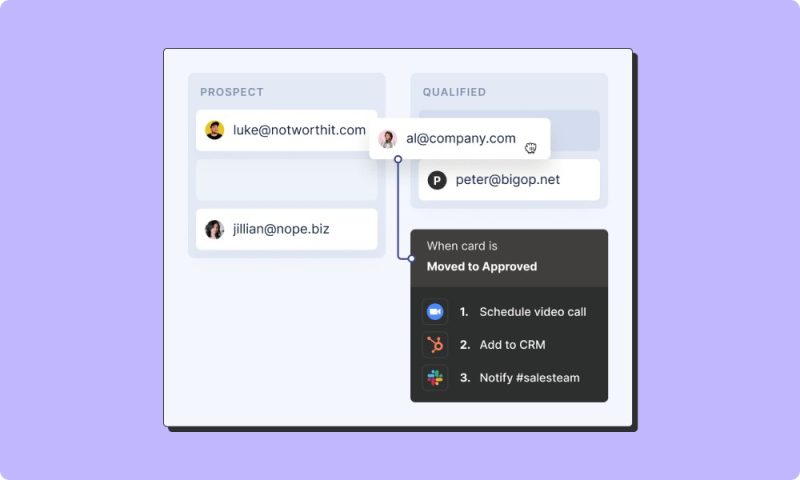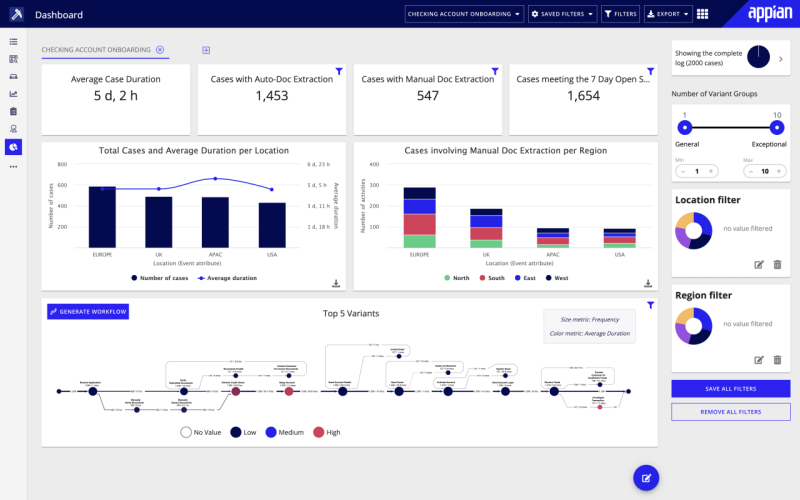AI-assisted process automation – table of contents:
The role of AI in business process automation
AI is changing business process automation in several important ways:
- makes process mapping easy – creating detailed process maps for workflow analysis can be extremely time-consuming, and prone to human error. AI automates process mapping, quickly creating effective graphs by analyzing data from event logs. This makes mapping faster, more accurate and more efficient,
- gives the ability to make changes in real-time – one of the great advantages of AI is the ability to monitor processes in real-time, not just after the fact. This enables dynamic adaptation to changing conditions. For example, AI can automatically reorder steps or create new process paths to deal with increased workloads,
- automatic pattern recognition – AI instantly detects patterns hidden deep in the data, such as reasons for delays in processes. In the hiring process, it can pinpoint the stages at which candidates are most likely to drop out. These insights allow for targeted optimization,
- automating repetitive tasks – with automation, artificial intelligence can take over invoicing, data entry, and transferring documents between systems, as well as other monotonous tasks. This allows employees to tackle more demanding projects.
How can intelligent automation transform a company?
Intelligent process automation can make a company, with the same team, more efficient in the area where it has implemented AI. Intelligent process automation can improve a company’s performance primarily in the following areas:
- production,
- marketing
- customer service,
- logistics.
For example, a Volkswagen plant in Germany has deployed “collaborative robots” to work side-by-side with workers in engine assembly. These robots take over the most physically demanding tasks, preventing injuries, while improving quality and production speed.
The automation of the customer service process is familiar to most people from their experience with banking or the insurance industry. Here, a large part of the purchase path is handled by virtual AI agents who can perform repetitive tasks – from automating policy processing to selling financial products to making suggestions on how to handle claims. Bots can respond to customer inquiries 24/7 and process claims up to 2.5 times faster than agents.
Automated delivery planning algorithms are also the domain of intelligent process automation:
- optimization of delivery routes,
- automatically adjusting inventory levels, whether
- increase the speed of delivery
- translate into increased customer satisfaction, reduced miles traveled, and savings due to fewer stored goods.
The first steps to smart process automation in your business. Where do you start?
If you want to take advantage of intelligent process automation in your company, consider at the outset what area of the business you want to automate. Fully digital processes are the easiest to optimize, while the biggest savings can come from automating manufacturing and logistics processes. Here are some best practices to keep in mind regardless of your chosen area of implementation:
- Start small – begin with a narrowed pilot project focusing on 1-2 repetitive processes prone to human error. Clearly define goals and measures of success at the very beginning of planning,
- Choose the right processes – look for repetitive tasks with clear rules that do not require decision-making. These are prime candidates for automation,
- Talk to employees and customers – engage all stakeholders early to get their input and support. Let them help define the goals and measures of success for business process automation. This will certainly make implementation easier down the road,
- Develop metrics – consider whether you care most about time savings, error reduction, or cost reduction. Audit and share results to show value and justify expanding automation,
- Celebrate small victories – look for the first few automation successes to start demonstrating the value of the implemented solutions right away. This builds good ground for larger initiatives and gets employees to start looking for processes among their duties that can be automated.
What AI tools to use to automate processes?
Among the most popular no-code tools for process automation are Zapier and Make. They are simple to use, so they give you the ability to quickly prototype a solution, for example:
- rules-based chatbot,
- lead management,
- product onboarding.

Source: Zapier (https://zapier.com/)
Unfortunately, the performance of solutions created with their help is often insufficient for use in business on a larger scale. Therefore, let’s take a look at examples of process automation solutions dedicated to business.
Appian BPM Suite
Appian BPM Suite is a business process management software that uses artificial intelligence (AI) to optimize and automate business processes. Here are some of its features and benefits:
- allows you to create processes by dragging and dropping elements on the diagram – no programming required,
- you can choose the right tool for your tasks, such as API integration, RPA, AI, business rules and others,
- provides scalable automation through a secure architecture,
- enables flexible adaptation of processes to changing organizational and market needs,
- helps create simple applications for use in the company, offering AI tips and advice inside Appian’s process modeler,
- features real-time tracking and measurement of process performance to ensure compliance, increase efficiency and reduce errors.
Appian’s AI Skill Designer tool enables the secure processing of large-scale content using artificial intelligence, which translates into the creation of custom machine learning models on private data, enabling the creation of unique AI solutions tailored to business needs without the need for data science skills. With AI Skill Designer, you can apply AI to key use cases such as email classification, document classification and document extraction – all within a Low Code solution. To use AI Skill Designer, simply add the AI module as you would any other design object, without the need for third-party software or datasets.

Source: Appian (https://appian.com/)
ADONIS BPM Suite
ADONIS is a tool similar in its operation to the Appian BPM Suite. It is used to manage business processes (BPM), helps create and optimize processes and even builds a digital twin of an organization (digital twin). ADONIS offers many functionalities, such as:
- Modeling processes using BPMN graphical notation and creating full process documentation in a single database,
- Analyze and optimize processes using dynamic charts and simulations,
- sharing and validating process information through the process portal,
- Cooperation and involvement of all stakeholders in the management of processes through comments, exchange of information and ideas
An additional feature of ADONIS is Elli, a chatbot that helps users handle the tool. Elli answers questions in natural language and provides advice on how to search for content in the ADONIS repository, as well as on how to use the tool. It also provides additional information on specific topics or directs users to useful online resources on BPM sites.
Summary. Why invest in AI-enabled process automation?
Artificial intelligence-assisted process automation is no longer just a dream of futurists but is becoming a standard in many business sectors. Investment in such solutions brings tangible benefits, such as increased efficiency, reduced operating costs and improved customer service.
But why invest in AI-enabled process automation? Here are some key reasons:
- Increase productivity and efficiency. Automating business processes using AI allows repetitive tasks to be completed faster and more accurately. This reduces the workload of employees, allows them to focus on more strategic aspects of their work and increases the overall productivity of the company.
- Cost reduction. Automating tasks that previously required manual intervention reduces operational costs. Organizations can make better use of human resources while minimizing errors and delays.
- Improving service quality. Artificial intelligence can analyze huge amounts of data faster and more accurately than humans. As a result, companies can better understand customer needs and respond to them more quickly, resulting in higher service quality.
- Flexibility and scalability. AI enables companies to quickly adapt to changing market conditions and easily scale processes as the company grows.
- Innovation and competitive advantage. Companies that invest in intelligent automation solutions often become leaders in their industries. Technological innovation translates into better products and services, which in turn attracts new customers.
In an era where technology is rapidly evolving and competition in the market is constantly increasing, companies that do not take advantage of AI capabilities in process automation may be left behind. That’s why it’s so important not only to follow the development of technology but also to actively implement it in their business processes.
Finally, it is worth remembering that AI-enabled automation is not just a matter of technology, but also a new way of thinking about business. Engaging AI into business processes is not just an investment in technology, but more importantly an investment in the future of the company. It’s a transformation that is often challenging but opens the door to new opportunities and innovations that can change the face of your organization.

If you like our content, join our busy bees community on Facebook, Twitter, LinkedIn, Instagram, YouTube, Pinterest, TikTok.
Author: Robert Whitney
JavaScript expert and instructor who coaches IT departments. His main goal is to up-level team productivity by teaching others how to effectively cooperate while coding.
AI in business:
- Threats and opportunities of AI in business (part 1)
- Threats and opportunities of AI in business (part 2)
- AI applications in business - overview
- AI-assisted text chatbots
- Business NLP today and tomorrow
- The role of AI in business decision-making
- Scheduling social media posts. How can AI help?
- Automated social media posts
- New services and products operating with AI
- What are the weaknesses of my business idea? A brainstorming session with ChatGPT
- Using ChatGPT in business
- Synthetic actors. Top 3 AI video generators
- 3 useful AI graphic design tools. Generative AI in business
- 3 awesome AI writers you must try out today
- Exploring the power of AI in music creation
- Navigating new business opportunities with ChatGPT-4
- AI tools for the manager
- 6 awesome ChatGTP plugins that will make your life easier
- 3 grafików AI. Generatywna sztuczna inteligencja dla biznesu
- What is the future of AI according to McKinsey Global Institute?
- Artificial intelligence in business - Introduction
- What is NLP, or natural language processing in business
- Automatic document processing
- Google Translate vs DeepL. 5 applications of machine translation for business
- The operation and business applications of voicebots
- Virtual assistant technology, or how to talk to AI?
- What is Business Intelligence?
- Will artificial intelligence replace business analysts?
- How can artificial intelligence help with BPM?
- AI and social media – what do they say about us?
- Artificial intelligence in content management
- Creative AI of today and tomorrow
- Multimodal AI and its applications in business
- New interactions. How is AI changing the way we operate devices?
- RPA and APIs in a digital company
- The future job market and upcoming professions
- AI in EdTech. 3 examples of companies that used the potential of artificial intelligence
- Artificial intelligence and the environment. 3 AI solutions to help you build a sustainable business
- AI content detectors. Are they worth it?
- ChatGPT vs Bard vs Bing. Which AI chatbot is leading the race?
- Is chatbot AI a competitor to Google search?
- Effective ChatGPT Prompts for HR and Recruitment
- Prompt engineering. What does a prompt engineer do?
- AI Mockup generator. Top 4 tools
- AI and what else? Top technology trends for business in 2024
- AI and business ethics. Why you should invest in ethical solutions
- Meta AI. What should you know about Facebook and Instagram's AI-supported features?
- AI regulation. What do you need to know as an entrepreneur?
- 5 new uses of AI in business
- AI products and projects - how are they different from others?
- AI-assisted process automation. Where to start?
- How do you match an AI solution to a business problem?
- AI as an expert on your team
- AI team vs. division of roles
- How to choose a career field in AI?
- Is it always worth it to add artificial intelligence to the product development process?
- AI in HR: How recruitment automation affects HR and team development
- 6 most interesting AI tools in 2023
- 6 biggest business mishaps caused by AI
- What is the company's AI maturity analysis?
- AI for B2B personalization
- ChatGPT use cases. 18 examples of how to improve your business with ChatGPT in 2024
- Microlearning. A quick way to get new skills
- The most interesting AI implementations in companies in 2024
- What do artificial intelligence specialists do?
- What challenges does the AI project bring?
- Top 8 AI tools for business in 2024
- AI in CRM. What does AI change in CRM tools?
- The UE AI Act. How does Europe regulate the use of artificial intelligence
- Sora. How will realistic videos from OpenAI change business?
- Top 7 AI website builders
- No-code tools and AI innovations
- How much does using AI increase the productivity of your team?
- How to use ChatGTP for market research?
- How to broaden the reach of your AI marketing campaign?
- "We are all developers". How can citizen developers help your company?
- AI in transportation and logistics
- What business pain points can AI fix?
- Artificial intelligence in the media
- AI in banking and finance. Stripe, Monzo, and Grab
- AI in the travel industry
- How AI is fostering the birth of new technologies
- The revolution of AI in social media
- AI in e-commerce. Overview of global leaders
- Top 4 AI image creation tools
- Top 5 AI tools for data analysis
- AI strategy in your company - how to build it?
- Best AI courses – 6 awesome recommendations
- Optimizing social media listening with AI tools
- IoT + AI, or how to reduce energy costs in a company
- AI in logistics. 5 best tools
- GPT Store – an overview of the most interesting GPTs for business
- LLM, GPT, RAG... What do AI acronyms mean?
- AI robots – the future or present of business?
- What is the cost of implementing AI in a company?
- How can AI help in a freelancer’s career?
- Automating work and increasing productivity. A guide to AI for freelancers
- AI for startups – best tools
- Building a website with AI
- OpenAI, Midjourney, Anthropic, Hugging Face. Who is who in the world of AI?
- Eleven Labs and what else? The most promising AI startups
- Synthetic data and its importance for the development of your business
- Top AI search engines. Where to look for AI tools?
- Video AI. The latest AI video generators
- AI for managers. How AI can make your job easier
- What’s new in Google Gemini? Everything you need to know
- AI in Poland. Companies, meetings, and conferences
- AI calendar. How to optimize your time in a company?
- AI and the future of work. How to prepare your business for change?
- AI voice cloning for business. How to create personalized voice messages with AI?
- Fact-checking and AI hallucinations
- AI in recruitment – developing recruitment materials step-by-step
- Midjourney v6. Innovations in AI image generation
- AI in SMEs. How can SMEs compete with giants using AI?
- How is AI changing influencer marketing?
- Is AI really a threat to developers? Devin and Microsoft AutoDev
- AI chatbots for e-commerce. Case studies
- Best AI chatbots for ecommerce. Platforms
- How to stay on top of what's going on in the AI world?
- Taming AI. How to take the first steps to apply AI in your business?
- Perplexity, Bing Copilot, or You.com? Comparing AI search engines
- ReALM. A groundbreaking language model from Apple?
- AI experts in Poland
- Google Genie — a generative AI model that creates fully interactive worlds from images
- Automation or augmentation? Two approaches to AI in a company
- LLMOps, or how to effectively manage language models in an organization
- AI video generation. New horizons in video content production for businesses
- Best AI transcription tools. How to transform long recordings into concise summaries?
- Sentiment analysis with AI. How does it help drive change in business?
- The role of AI in content moderation


















